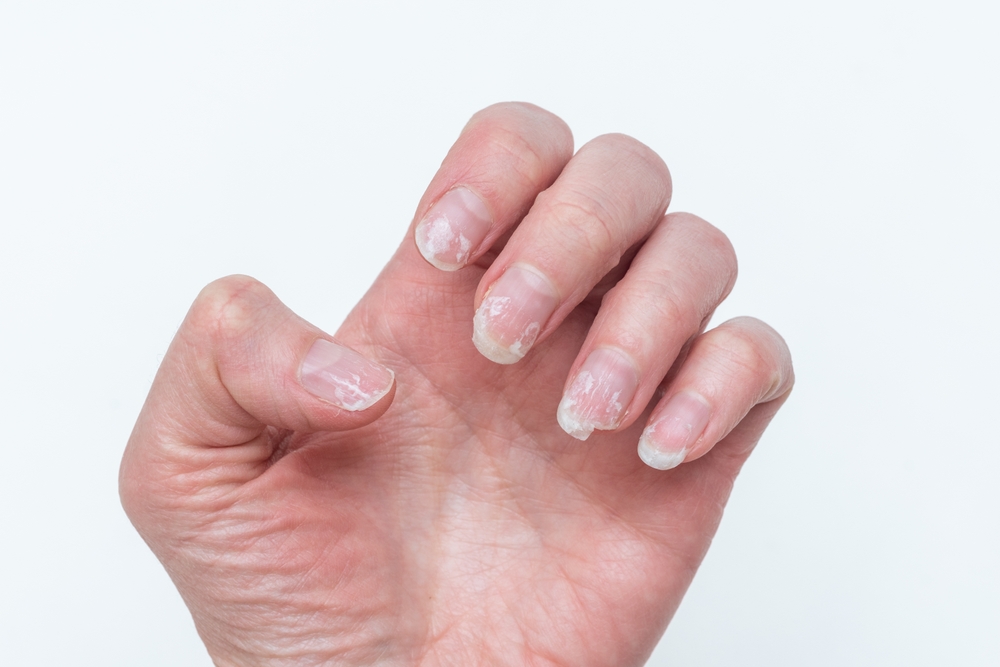Your brittle, peeling, ridged nails aren’t just annoying beauty problems—they’re your body’s early warning system broadcasting internal health issues that haven’t shown up anywhere else yet. Those weak nails that break at the slightest touch are essentially tiny billboards advertising nutritional deficiencies, hormonal imbalances, and systemic health problems that could be affecting your entire body.
Nail health is one of the most overlooked diagnostic tools in personal health monitoring, yet your fingertips provide real-time information about your circulation, nutrient absorption, hormone levels, and overall metabolic function. The condition of your nails often changes weeks or months before you notice other symptoms of underlying health issues.
What makes nail problems particularly frustrating is that most people treat them as cosmetic concerns with topical solutions when the real fixes require addressing internal imbalances that are causing the nail symptoms. No amount of cuticle oil or strengthening polish can fix nails that are brittle because your body lacks the building blocks to create healthy nail tissue.
Your thyroid is sabotaging your nail growth
Thyroid dysfunction is one of the most common but overlooked causes of brittle nails, affecting millions of people who don’t realize their nail problems are connected to their hormone levels. Both hyperthyroidism and hypothyroidism can create nail changes that appear months before other thyroid symptoms become obvious.
Hypothyroidism slows down cellular processes throughout your body, including the rate at which your nails grow and regenerate. When your thyroid is underactive, nails grow slowly, become thick and brittle, and develop ridges that reflect the inconsistent growth patterns caused by hormonal fluctuations.
The protein synthesis required for healthy nail formation depends on adequate thyroid hormone levels. When thyroid function is compromised, your body can’t produce the keratin proteins needed for strong, flexible nails, resulting in brittle, weak nail plates that split and peel easily.
Circulation problems associated with thyroid dysfunction reduce blood flow to your nail beds, limiting the delivery of nutrients and oxygen needed for healthy nail growth. Poor circulation to extremities often shows up in nail health before affecting other body parts.
Temperature regulation issues from thyroid problems affect nail growth patterns, as cold hands and feet create conditions that interfere with normal nail development. Many people with undiagnosed thyroid issues notice their nail problems worsen during cold weather when circulation is further compromised.
Nutritional deficiencies are literally starving your nails
Protein deficiency is the most common nutritional cause of brittle nails because nails are made primarily of keratin, a protein that requires adequate amino acid intake to synthesize properly. Many people following restrictive diets or eating insufficient protein develop nail problems within weeks.
Iron deficiency creates spoon-shaped, thin, brittle nails that break easily and may appear pale or have white spots. This deficiency is particularly common in women of reproductive age and can affect nail health long before anemia develops or other iron deficiency symptoms become apparent.
Biotin deficiency, while relatively rare from diet alone, can be caused by certain medications, digestive issues, or genetic factors that interfere with biotin absorption. This B vitamin is crucial for nail strength, and deficiency creates characteristically brittle, splitting nails.
Zinc deficiency shows up in nails as white spots, slow growth, and increased brittleness. This mineral is essential for protein synthesis and cellular repair processes that maintain healthy nail tissue. Zinc absorption can be impaired by certain medications and digestive conditions.
Omega-3 fatty acid deficiency creates dry, brittle nails that lack flexibility. These essential fats are incorporated into cell membranes throughout the body, including nail cells, and deficiency makes nails more prone to cracking and breaking.
Your digestive system is failing to feed your nails
Poor digestive health directly affects nail quality because nutrient absorption occurs in the intestines, and any impairment in digestion reduces the availability of nutrients needed for healthy nail growth. Many people with brittle nails actually have adequate nutritional intake but poor absorption.
Stomach acid deficiency, which becomes more common with age and certain medications, impairs the absorption of minerals like iron, zinc, and calcium that are essential for nail health. Low stomach acid also affects protein digestion, reducing the amino acids available for keratin synthesis.
Small intestinal bacterial overgrowth creates inflammation and nutrient malabsorption that directly affects nail health. The bacterial imbalance interferes with vitamin B12 and other B vitamin absorption while creating inflammatory compounds that affect nail growth.
Celiac disease and gluten sensitivity damage intestinal villi and create malabsorption that often shows up in nail changes before digestive symptoms become severe. Many people discover their gluten issues through persistent nail problems that improve dramatically with gluten elimination.
Inflammatory bowel conditions like Crohn’s disease and ulcerative colitis create systemic inflammation and nutrient malabsorption that affect nail health. The chronic inflammation interferes with normal cellular processes needed for healthy nail growth.
Hormonal chaos is wreaking havoc on your nail matrix
Estrogen fluctuations during menstrual cycles, pregnancy, and menopause directly affect nail growth and strength. Many women notice their nails become more brittle during certain phases of their cycle or experience dramatic nail changes during hormonal transitions.
Insulin resistance and diabetes affect circulation and nutrient delivery to nail beds while creating advanced glycation end products that interfere with normal cellular function. Blood sugar instability creates inconsistent nutrient delivery that shows up as ridges and weakness in nails.
Cortisol elevation from chronic stress interferes with protein synthesis and cellular repair processes needed for healthy nail growth. Stress hormones also affect nutrient absorption and can create deficiencies that manifest as nail problems.
PCOS and other hormonal conditions that affect androgen levels can create changes in nail thickness, growth rate, and overall health. The complex hormonal imbalances affect multiple systems that support nail health.
Adrenal fatigue, while controversial as a diagnosis, represents a pattern of stress-related hormone dysregulation that often includes nail changes as an early symptom. The exhausted stress response system can’t support optimal cellular function needed for healthy nails.
Environmental toxins are poisoning your nail growth
Heavy metal exposure from contaminated water, food, or environmental sources can accumulate in nail tissue and interfere with normal growth processes. Lead, mercury, and aluminum create oxidative stress that damages nail cells and interferes with healthy growth patterns.
Chemical exposure from cleaning products, nail products, and occupational hazards can create contact sensitization and systemic toxicity that affects nail health. Many nail problems improve dramatically when toxic exposures are identified and eliminated.
Smoking affects circulation to extremities and creates oxidative stress that interferes with nail health. The reduced oxygen delivery and increased free radical damage create conditions that promote brittle, unhealthy nails.
Medication side effects from antibiotics, chemotherapy drugs, and other pharmaceuticals can affect nail growth and strength. Many medications interfere with nutrient absorption or create deficiencies that manifest as nail problems.
Water quality issues including chlorine, fluoride, and other chemicals can affect nail health through both topical exposure and systemic effects from consumption. Hard water can also create mineral deposits that affect nail and skin health.
Fixing your nails from the inside out
Comprehensive blood testing including thyroid function, iron levels, vitamin D, B12, and inflammatory markers can identify the underlying causes of brittle nails and guide targeted treatment approaches. Most nail problems reflect systemic issues that show up in blood work.
Digestive health optimization through elimination diets, probiotic supplementation, and addressing underlying gut issues often resolves nail problems more effectively than topical treatments. Healing the gut frequently heals the nails.
Targeted supplementation based on identified deficiencies can dramatically improve nail health within 3-6 months. However, supplementation should be guided by testing rather than guesswork to avoid creating imbalances.
Stress management and sleep optimization support the hormonal balance and cellular repair processes needed for healthy nail growth. These lifestyle factors often provide more dramatic improvements than cosmetic nail treatments.
Reducing toxic exposures through water filtration, organic food choices, and non-toxic personal care products creates conditions that support healthy nail growth while reducing the burden on detoxification systems.
Patience is essential because nails grow slowly, and improvements in underlying health take 3-6 months to become visible in nail quality. The nail changes you see today reflect your health status from several months ago.
Understanding that nail health reflects overall health helps prioritize systemic approaches over cosmetic fixes. Healthy nails are a byproduct of good health, not something that can be created through external treatments alone.
The goal isn’t perfect nails but rather using nail health as a monitoring tool for overall wellness while addressing the root causes that create strong, healthy nails as a natural consequence of optimal health.


















